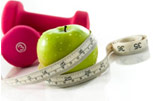Weight Loss Resources
Hundreds of articles about weight loss ...
Are the fat percentage scales right?
Hi, My son has been giving me one to one personal training sessions. He decided to weigh me and see what my stats were. Not sure if this can be true or not but when I started the scales said I was 94.6 kg, 46.2% Fat, 45.0% Muscle and 37.6% Water. Yesterday they said 92.7 kg 30.3% Fat 57.5% Muscle and 48.8% Water. So according to his figures I had lost 15.1 lb of Fat. He didn't believe it so got me to go on the scales again. Not sure whether to believe it so am going to have my stats taken at my gym and see what theirs say. I'm not losing weight but people keep saying when I go swimming my shape has changed Am not fully sure how it all works, but have lost inches. Thanks
Our expert says...
Hi,
There are some inherent inaccuracies with scales that assess ‘fat percentage’ from a standing position so there is a possibility that the one/both readings are somewhat off the mark. Scales that you stand on only measure the composition of the lower part of your body because the electrical impulse always travels the shortest route and travels up one leg and down the other, totally bypassing the upper body. This is the same flaw of hand held devices where the impulse travels up one arm, across the upper body and down the other arm, bypassing the lower body. So although these devices are very useful in their own right (with consideration to their bias) to use as an ongoing comparison, they are not as accurate as a Body Stat / Bioelectrical Impedance (BIA) machine where an electrode is attached to one hand and one leg.
As a trainer I only ever use the electrical impulse fat percentage measuring method in conjunction with calliper measurements and with circumferences. The calliper and circumference approach gives a very true reflection of actual changes specific to different body parts and if the person doing the measurements is experienced then instructor error is minimal. This method would more accurately reflect the actual lean muscle and fat percentage changes you make in the various body parts. Well done to your son for getting some measurements for you, to add to it I would see if the gym can do the circumference and/or calliper and/or the BIA method of measuring fat percentage to give you a bigger overall insight in to how your body is changing from your swimming.
The BIA machines are the next best thing to underwater weighing (that is very costly and unpractical outside of a lab) and has a 99.9% accuracy reading. BIA is not a scale you stand on but is where someone lies down and an electrode is attached to one hand and one foot. This allows for a more balanced, whole body reading and provides a more accurate reading of water, body fat composition and lean muscle mass. However, that said, it is important to know that any kind of electrical impulse measure is susceptible to the limitation relating to water % - i.e. if someone is dehydrated the fat percentage will be skewed higher so ensure you are adequately hydrated to between 55-65% water composition. Looking at your initial reading on your scales your water percentage is incredibly low and this may have given a falsely high reading to begin with.
Alternatively, your son’s PT efforts and your hard work may just be paying off so keep it going! Well done.
Hope this helps,
Kelly
Disclaimer
You are advised to seek medical advice before making any changes to your diet or lifestyle with an aim of weight loss. This website and the content provided should not be used by persons under 18, by pregnant or nursing women, or individuals with any type of health condition, except under the direct supervision of a qualified medical professional. The information contained in these articles, and elsewhere on this website, is provided for educational and entertainment purposes only, and is not intended to replace, and does not constitute legal, professional, medical or healthcare advice or diagnosis and may not be used for such purposes. Continue...

